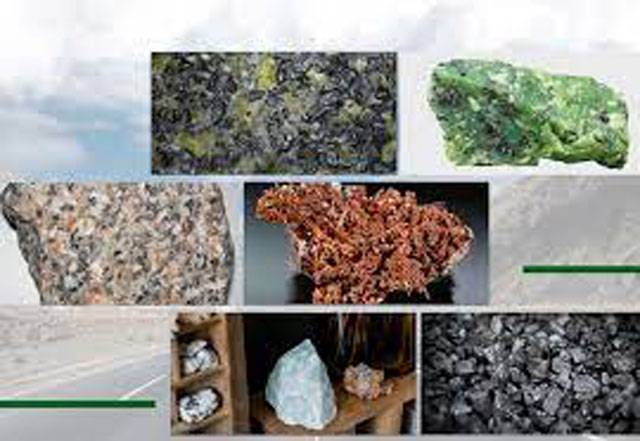ISLAMABAD - Exquisite deposits of tourmaline are yet to be exploited in Pakistan for great economic benefits. Indigenous processing of tourmaline for different industrial purposes can fetch a fortune for the country. Unique land formations of Pakistan are swollen with this industrially-rich gem assortment.
Depending on quality, tourmaline worth $50 to $50,000 per carat is used for a variety of commercial purposes. Muhammad Yaqub, principal geologist at Global Mining Company and former general manager of geology in Pakistan Mineral Development Corporation, told WealthPK that different kinds of tourmaline are extracted in Pakistan, including bi-colour varieties like deep-sea blue. “The occurrence of gem-quality tourmaline is reported from Chitral in Khyber Pakhtunkhwa and Shigar and Stak in Gilgit-Baltistan (GB) region. Chitral and GB are considered the main mining hubs of tourmaline. The green variety of tourmaline is also reported from Koh-i-Suleman ranges and it is of high-gem quality seeming like an emerald. Naturally, it is found in the crystalised form in different colours and sizes. It is formed within the granitoids of the late magmatic stage and metamorphic rocks as well,” he explained.
Assistant Director of the Geological Survey of Pakistan Yasir Shaheen Khalil, in a discussion with WealthPK, said tourmaline is mined in many places in the country, but is not quantified yet. “Non-gem quality tourmaline is a good source to get boron, which is used in many industrial applications. It is found in plenty in Pakistan, but a systematic method is needed to mine and market it.” Gemmologist and miner Imran Babar told WealthPK that tourmaline belongs to the boron silicate family of minerals. “Due to many inclusions, it shades differently. Mostly it is found in granitic mountains and also matrix gypsum/ mica/garnet/quartz, etc. Big pockets in Khyber Pakhtunkhwa province are mostly loaded with sizeable black variety. Other hues are violet, green, bluish, light pink, yellow, champagne, etc. Almost all colours and varieties of tourmaline are found in Pakistan. Non-gem quality tourmaline can also be processed to get boron as well,” he explained.
Tourmaline is a crystalline silicate mineral group in which boron is compounded with iron, aluminum, lithium, magnesium, sodium, potassium, etc, and is found in a wide variety of colours. It is also one of those minerals produced from a single mining location. It is extremely hard to scratch that it almost blunts the steel knife having a hardness rate between 7 to 7.5 on the Mohs hardness scale. Known tourmaline species are elbaite, liddicoatite, dravite, uvite, and Schorl. It is also called the electric stone as when heated, it gets an electric charge. The allochromatic tourmaline is considered magnetic due to high concentrations of iron/manganese. Green tourmaline, free of inclusions, transparent, and of good colour is considered rare, valued and highly coveted. Tourmaline with a pink centre and green perimeter around the outside is called watermelon tourmaline. Blue tourmaline or indicolite is also a rare variety that gets its colour from tiny iron impurities mostly found in Brazil, Nigeria and Afghanistan.
Pink tourmaline is also the most sought-after variety of tourmaline. In black colour, it is called Schorl. The rarest and most expensive of them is called Paraiba having the hue of neon-like blue and green with copper traces. Tourmaline is used for many industrial purposes, including agriculture, paints, cosmetics, especially in hair-care products, jewellery, textiles, water purification, etc. Black tourmaline (Schorl) is used to absorb pyroelectricity, emissions of far infrared radiation, ions’ adsorption, negative air ions, detoxifier, and the influence of biological activity. During WW-II, black tourmaline was used for blast gauges and it was the one and only material that transmitted the pressure data before the guage was destroyed. Tourmaline is widely used in shrines, rituals, grids and meditation practices, etc. Its crystal needles were also used for acupuncture in its nascent years. Pink tourmaline is still used in traditional Chinese medicines.
Thursday, April 18, 2024
Indigenous processing of tourmaline can benefit Pakistan’s economy

President summons Senate session on April 22
9:07 PM | April 18, 2024
Turkish top general calls on CJCSC Sahir Shamshad Mirza
9:06 PM | April 18, 2024
Filling superior courts' vacancies top priority: CJP
9:05 PM | April 18, 2024
PM says will personally monitor Saudi investment in Pakistan
9:04 PM | April 18, 2024
PTI nominates Shibli Faraz to be opposition leader in Senate
9:03 PM | April 18, 2024
Hepatitis Challenge
April 18, 2024
IMF Predictions
April 18, 2024
Wheat War
April 18, 2024
Rail Revival
April 17, 2024
Addressing Climate Change
April 17, 2024
Justice denied
April 18, 2024
AI dilemmas unveiled
April 18, 2024
Tax tangle
April 18, 2024
Workforce inequality
April 17, 2024
New partnerships
April 17, 2024
ePaper - Nawaiwaqt
Advertisement
Nawaiwaqt Group | Copyright © 2024





